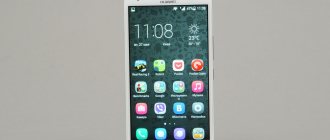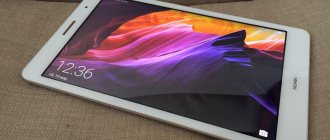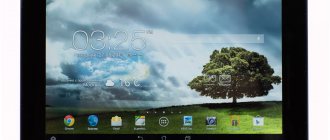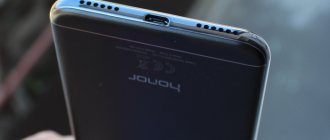At the end of 2020, Asus decided to introduce ASUS ZenFone Max Plus, which incorporated all the main features of 2020 that are typical of flagships: a dual main camera, a screen with an as yet unusual 18:9 aspect ratio, capable of displaying more content, as well as unlocking by face. Do you expect such features exclusively from flagships? But no, we are offered an affordable device, which, in addition to all of the above, has an all-metal body and a recognizable design. In this article we will review the ASUS ZenFone Max Plus and figure out how successful this model turned out to be.
Technical characteristics of ASUS ZenFone Max Plus:
- Screen: IPS, 5.7″, 2160×1080, capacitive, multi-touch, 2.5D
- Processor: eight-core MediaTek MT6750T, 1.5 GHz
- Graphics accelerator: Mali-T860
- Operating system: Android 7.0 Nougat with ZenUI 4.0 shell
- RAM: 3 GB
- Built-in memory: 32 GB
- Memory card support: microSD up to 256 GB (separate slot)
- Communication: GSM 850/900/1800/1900 MHz || UMTS 850/900/1900/2100 MHz || LTE: 1, 3, 5, 7, 8, 34, 38, 39, 40, 41
- SIM: 2x nano-SIM, Dual SIM Dual Standby (DSDS)
- Wireless interfaces: WiFi 802.11 b/g/n, Bluetooth 4.0
- Navigation: GPS, A-GPS GLONASS
- Cameras: main - 16 MP lens + 8 MP wide-angle (flash, autofocus), front - 8 MP
- Sensors: light, motion, microgyroscope, accelerometer, magnetometer, fingerprint sensor
- Battery: 4130 mAh, non-removable
- Dimensions: 152.6x73x8.8 mm
- Weight: 160 grams
Appearance.
Dimensions 73x152.6x8.8 mm. Weight 160 g. Housing: aluminum. In terms of design, Asus apparently didn’t bother, perhaps there is no room for imagination, or maybe it’s just laziness. Pegasus is also similar to the first-born in the mid-price segment (18:9) LG q6, in many ways it resembles Redmi 5, and in general almost all smartphones with this format, in general it’s not bad, it doesn’t look any worse, it’s very I liked it, although I didn’t have a wow effect, it looks good, it’s just that this design has become a little boring.
According to the manufacturer, the 5.7-inch screen occupies 80% of the front side, covered with 2.5D glass. On the front side there is a front camera, a speaker, proximity and light sensors, and a three-color (green, red, yellow) event indicator. Below there is an empty space without inscriptions, where, in fact, one could put touch buttons, but the manufacturer decided to make do with on-screen buttons.
The entire rear part, except for the plastic inserts on the bottom and top, is made of aluminum.
In the middle there is a fingerprint sensor, above there is a module of two cameras, 16 and 8 MP, the camera is under glass, and with a metal frame. Nearby is a single-color flash.
The ASUS inscription is located modestly at the bottom.
On the left side there is a slot for 2 nano SIM cards and one micro SD.
On the right is a metal power and volume button.
At the bottom there is a USB port, it’s a pity, but it’s a regular micro, not type c, a microphone on the left, a speaker on the right.
On top there is a 3.5 mm audio jack and an auxiliary microphone.
Made with high quality, without backlash, defects, or creaking when pressed.
Design ASUS ZenFone Max Plus
When you first get acquainted with the smartphone, the absence of plastic inserts on the metal back immediately catches your eye. In fact, they are present at the top and bottom of the case, but everything is done so neatly that you hardly notice them. A dual camera module was installed in the left corner, which protrudes noticeably beyond the body. In addition to it, there is a flash with different color temperatures, a noise-cancelling microphone and the Asus brand logo.
The protruding block with cameras is a concern, but it should not be damaged due to the fact that it is slightly recessed into the metal frame. The solution might seem simple, but many phones lack exactly this. As a result, you don’t have to worry about damaging the camera sensor when you place it on its back on a table or other surface.
As the ASUS ZenFone Max Plus m1 review showed, space for a 3.5 audio jack was allocated on top.
The bottom edge is occupied by a standard microUSB port, on either side of which the main speaker and microphone are located. The port supports connecting external devices via OTG and can even share charge with them, allowing you to use ZenFone Max as an external battery.
A hybrid slot has been placed on the left side, into which you can install two SIM cards or sacrifice one by replacing it with microSD.
On the right side, directly under the thumb, there is a volume rocker and a screen power button.
The front side is covered with protective glass with rounded edges (2.5D). Its upper part is occupied by the sensors already familiar to everyone, the front camera, the earpiece and the LED notification indicator. A high-quality oleophobic coating is applied to the surface of the display.
A mechanical “Home” key was installed under the screen, but in addition to its main purpose, it plays the role of a fingerprint scanner. It accurately recognizes touches, but when the screen goes dark it reacts with a short pause. But the navigation keys are on-screen, which is typical for Asus smartphones.
Display
ASUS ZenFone Max Plus m1 zb570tl review moves to a 5.7-inch display with FullHD+ resolution (2160×1080 pixels). It is surrounded by thin frames and the edges are rounded. This is a high-quality IPS matrix with its characteristic wide viewing angles and natural color rendition. The factory calibration of the matrix is optimal, although if you wish, you can change the color temperature to your liking.
The brightness reserve is enough to comfortably use the phone in bright daylight conditions - 500 cd/m2. A review of the ASUS ZenFone Max Plus smartphone shows that it supports up to 10 simultaneous presses. In the cold season, the glove control mode will be useful, which increases the sensitivity of the display. Unique features include gesture control on the locked screen.
Screen
The smartphone has a 5.7-inch screen with an IPS matrix and a resolution of 1440×720 pixels, sold in Russia, and the CIS version was renamed Asus ZenFone Max Plus, with a difference in increased resolution of 2160×1080 pixels. The screen occupies the main area of the front part (80%, in the GSMArena arena they say 75%), the side frames are 3mm, the bottom and top are 11.
In general, the screen turned out to be decent, it has good color rendition, the viewing angles also have good performance with a slight drop in brightness, visually it looks good, in no way inferior to competitors in its price category. But it has disadvantages. The first is low brightness, comfortable to use, but inferior to competitors, and the second screen settings, such as the lack of color temperature settings, there is a blue background, the ability to change fonts, including downloaded ones, its size, and basically everything is not important to me, but For some, such limited settings will be a disadvantage.
One of the interesting features is working with gloves, I tested both winter gloves (quite thick) and ordinary work gloves, the function works well. You can change the location and display type of on-screen buttons. There are screen reduction functions and multi-window mode (split screen).
Since not all programs support 18:9, the smartphone stretches them to fit its screen, the image does not deteriorate, in Honor this was done more conveniently, went into the program, and the phone offers to stretch it, but in Pegasus you need to go to the settings, and there enable this function for each program.
Compared to the five inch Redmi 3s.
With Honorom.
If we compare screens with the 7X, then the second one will be better in terms of characteristics and customization options; the color rendition of both is good, but the Pegasus has more saturated and bright colors.
Performance
ASUS ZenFone Max Plus m1 technical specifications are based on a weak Mediatek MT6750 processor, which is very far from the flagship level. But if you do not plan to run modern toys, then the power will be more than enough. The processor is built on 4 cores up to 1.5 GHz and 4 up to 1 GHz. Graphics processing is performed by the Mali-T860 MP2 video chip - one of the most popular solutions in the budget category.
ASUS ZenFone Max Plus m1 specifications suggest the presence of 3 GB of RAM operating at a speed of 4000 MB/s. User memory is 32 GB, of which about 22 GB is available. Read speed reaches 134 MB/S, and write speed – 80 MB/S. After switching on, the system uses up half the amount of RAM, so there’s not much you can do here.
Synthetic test results
The review of the ASUS ZenFone Max Plus phone makes it clear that it should not be considered as a gaming device. It will run modern games at maximum on medium graphics. In tanks at maximum graphics, we only got 16 FPS; it’s comfortable to play only at minimum, when many aspects of the location are not drawn. There is no throttling, and after a couple of hours of playing the device only barely noticeably warmed up.
⇡#Hardware and performance
ASUS Zenfone Max Plus uses the Mediatek MT6750T platform, which is more typical for smartphones in the “under 10 thousand rubles” category. It has eight ARM Cortex-A53 processor cores, four of which operate at 1.5 GHz, and four more at 1.0 GHz. Graphics subsystem – ARM Mali-T860 MP2, 550 MHz. The chip is manufactured using a 28nm process technology. This is a system of that class for which clarification is still relevant - yes, it supports 64-bit computing.
Be that as it may, you won’t feel a serious drop in performance compared to the Qualcomm Snapdragon 4xx series - these are platforms of approximately the same order. The Mediatek SoC ensures quite normal operation of basic applications, fairly fast screen flipping and decent stability. But crashes from main applications and slowdowns during work still happen, albeit not critically often. In the first case, however, we should rather blame the firmware, and in the second, both it and the hardware.
Unfortunately, it’s better not to think about normal performance in games with 3D graphics - there are other smartphones for that. Simple puzzles and games with 2D graphics will work quite well on Zenfone Max Plus.
Max Plus has 3 GB of RAM and 32 GB of non-volatile memory. Moreover, you can expand the volume using a microSD memory card (capacity up to 256 GB) without sacrificing a second SIM card - triple slots are back, and Max Plus is at the forefront of a wonderful trend.
Interface
Asus Zenfone 4 Max Plus x015d review introduces the fact that the ZenUI 4.0 shell is superimposed on top of the standard Android 7.0. The interface has been redesigned beyond recognition, and if in the previous version it was illogical and overloaded, now they have done an excellent job of fixing the errors. Among the obvious differences, the bright design of the elements immediately catches the eye.
Asus Zenfone pegasus 4s max plus review shows that the manufacturer has added interesting options to the new version:
- Digital Media Server - phone content can be viewed from a computer or other device using an Internet connection, which is very convenient;
- The SOS key allows you to alert emergency services and send location information;
- Daily updated wallpapers and a large selection of themes;
- Simplified mode will be useful when using your phone as a navigator in a car.
Software
Android 7.0 Nougat with the ASUS ZenUI 4.0 add-on is a comprehensive redesign of the familiar operating system. We have already studied ZenUI 3.0, and then the operating system greeted the user with an abundance of pre-installed applications and an illogical, overloaded interface. In the new version, work has been done to correct the errors and we cannot say anything bad about the ZenFone Max Plus firmware.
The color scheme still remains quite bright, but it is not far from the usual minimalism of “pure” Android 7.0. But several useful functions have been added:
- Digital Media Server - allows you to turn your smartphone into a small file storage, allowing access via the Internet to documents stored in the device’s memory;
- The SOS button is used for emergency calls and quick sending of location data;
- Global design themes and daily changing wallpapers refresh the familiar appearance of the operating system;
- Simplified mode and children's mode will come in handy if ZenFone Max Plus is used by relatives.
In addition, we note that when setting up your smartphone, you can activate a promotional code for 100 GB of Google Drive storage for a year.
Wireless communications
ASUS ZenFone 4 Max Plus m1 review confirms the information that two SIM cards can be installed in the smartphone at the same time. Each slot supports the latest generation networks, but only one SIM card is connected to 4G. When buying a phone abroad, pay attention to the list of supported frequencies. They may vary depending on the modification.
There is a radio, Wi-Fi 2.4 GHz, Bluetooth 4 generations, GPS and GLONASS for terrain navigation. The location is determined quickly and correctly; a total of 21 satellites were found.
Connection
ASUS ZenFone Max Plus accepts two Nano SIM cards. To do this, a large metal tray is placed at the right end of the device. The cards in both slots work with 3G and 4G, but only one of the SIM cards can connect to the 4G network, but not both at the same time. Mobile network reception is stable. In Russia, a version of the smartphone is sold that supports all current mobile communication bands, but there are ZenFone Max Plus with a different set of frequencies. When purchasing smartphones abroad, this should be taken into account.
As for other wireless interfaces, ZenFone Max Plus can act as an FM receiver. The built-in Wi-Fi module operates in the 2.4 GHz band, Bluetooth version is 4.0.
GPS and GLONASS satellite systems are supported. Navigation works accurately, instantly detecting 21 satellites, and locates the device just as quickly.
Autonomy ASUS ZenFone Max Plus
The compact case managed to fit a battery with a capacity of 4130 mAh, which charges from the included charger in 2 hours 40 minutes.
Proprietary energy-saving mechanisms will help you last longer without a power outlet. It supports flexible customization for each application. The system automatically finds programs that consume battery power in the background and closes them.
There are several energy saving modes, including:
- Productive, in which brightness and performance will be at the maximum level;
- Standard - color rendering and performance are set depending on the current needs of the user;
- Energy saving disables data transfer when the screen is locked;
- Super energy-saving - all that remains is the ability to make calls and send SMS.
We tested the battery in performance mode, where it lasted 8 hours 21 minutes. Standard is only 3 minutes longer. In energy-saving mode, it worked for 8 hours and 34 minutes, so they don’t make much sense.
Cameras
We will start our review of the ASUS ZenFone Max Plus m 1 camera with an interface that attracts attention with many buttons. A switch from normal mode to wide-angle shooting is located in the center. A separate panel contains the most important parameters and transition to advanced settings. Next to the shutter button there is an advanced shooting mode, a video recording key, switching to the front camera and going to the gallery. By swiping in one direction you get access to additional shooting modes, and in the other - color filters.
The dual camera includes a main 16 MP lens and an 8 MP wide-angle module. PixelMaster technology improves image quality by increasing light sensitivity and speeding up focusing. When shooting automatically, problems with shutter speed sometimes appear. But in most cases, you manage to get a solid photo with well-drawn details the first time.
A small amount of noise appears in night shots, and color rendition is close to natural.
When shooting in HDR mode, the smartphone hesitates, but illuminates dark areas well.
In macro photography, the background is beautifully blurred, while the foreground remains in focus. Everything is as it should be. A single-color flash illuminates nearby objects, but does not distort color reproduction.
Example photo on ASUS ZenFone Max Plus
The additional lens of the main camera of ASUS ZenFone Max Plus is wide-angle - the viewing angle reaches 120 degrees. With its help you can take wide-format photographs, but they will have an order of magnitude worse detail and color rendition.
The front camera with a resolution of 8 megapixels pleases with natural color reproduction and detail. The manufacturer preinstalled the Selfie Master program, which uses software processing to improve your face. But traces of processing are still clearly visible; the algorithms are still far from perfect.
The panorama is stitched together sloppily, which is due to sudden jumps in auto-adjustment of white balance. At the same time, the detailing is at a high level. The standard Camera application can create GIFs, which can be played backwards if necessary.
Conclusion
After our review, ASUS ZenFone Max Plus leaves conflicting impressions. The main disadvantage was autonomy, which is surprising, because there were no problems with it before in smartphones from this manufacturer. It wouldn't hurt to improve the performance; the device copes with games with great difficulty. Otherwise, everything is fine - the system works smoothly even in split-screen mode, and the cameras manage to get very decent shots, especially if you play around with the manual settings.
Where can I buy?
Following the links you can buy a smartphone at the best prices:
Aliexpress GearBest Banggood
Comments for the
Cackl e
You might be interested in:











